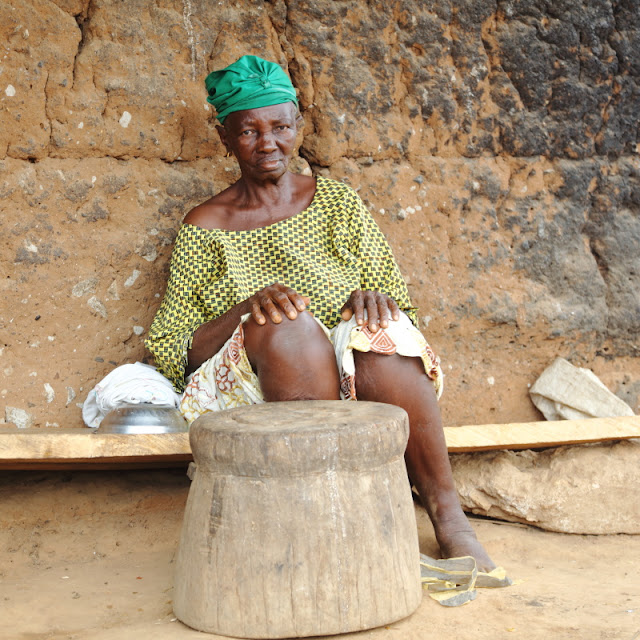 |
| too many people can cause a boat to sink |
About half an hour drive away from Oyo town, there is a small settlement, called Ile-Oba Alaafin, that is dedicated to Oba the river Spirit. Nowadays, five families are living there. About a hundred people. The name of all inhabitants starts with Oba to mark their origin. The legend says that Oba and Osun were both married to Sango, the god of thunder and they had a dispute. Osun cut one ear to Oba in the process and Oba turned into a river, hence became the river Spirit. The village is set in a peaceful location away from the main road linking Oyo to Ogbomoso and Ilorin, a dreadful stretch full of lorries humming their way at variable speeds. Overtaking certainly kills on that road whose sides are littered with skeletons of burnt-down vehicles.
 |
| The Champs Elysées of Ile Oba Alaafin |
It takes ten to fifteen minute over a sandy track, that traverses large fields punctuated by lonely trees, to reach the village by car. There is water in the vicinity, a river actually that swells during the rainy season to cover a large expanse of water which turns into a bush during the dry season. The river is famous for being the river in which Oba disappeared. Inhabitants of the village still practice a tradition that asks all pregnant mothers to declare if the father of the child is from the lineage of Oba. If yes, her new-born baby will be thrown in the water to prove whether the child can swim. If it does the child is acknowledged as a real blood member of the Oba clan. If the child drowns it means that the father of the child does not belong to the Oba clan. The mother is henceforth chased from the village to go and live with the child's father.
The land belongs to the Alaafin of Oyo. People from Ile Oba Alaafin regularly go fishing in the river and bring some fish to the Alaafin as retribution for the land ownership. The village has a T-shape as a result of the junction of two dirt tracks that meet in the center of the village. Its trees have beautiful intricate shapes and provide shade to what could be a steaming place during the day. At the T-junction is a gazebo for the elders to meet and discuss. Houses are made of clay, some of the outer walls are used to dry cow dung cakes. Roofs are made of corrugated iron sheets. A lady was frying small pieces of fish.
A priest brought us a fish smoked the day before which tasted very good but was full of bones. At the back of the village is a large area planted with trees where women process palm oil in several stages: collecting the red fruits, letting them ferment in water tanks heated with firewood for some time before being pressed to recuperate the oil. The seeds are kept aside to produce black oil.
There was also a place to produce garri.
 |
| sorting out palm fruits |
We visited the main house of the elder of the village, a elderly woman, whose son is the priest to Oba. A room is dedicated to the shrine which is materialised by a white cloth hung along the wall in a corner. A claypot with sacred water, next to it are symbols of spiritual realm like a long metal stick mounted with a semi-circle with each quarter pierced with 6 rings as a symbol of Iyemo the wife of Obatala. There are also two machetes of the type that were used to combat enemies of the village.
 |
| the Elder of Ile Oba Alaafin (she could swim when she was born) |
As we walked towards the river, a bit distant in this end of dry season, we saw another Oba shrine protected by a semi-spherical shed made of palm branches. The river was partly dry. A few men and plenty of excited children went around the corner to uncover a wooden boat, dug into a tree trunk, from underneath long palm leaves. A lady brought it closer to us using a perch of bamboo. She was soon friendly assaulted by a group of young kids who all wanted to be part of the ride on the boat. Soon the boat drowned because the weight of the children was just too much. Everyone, including the lady, ended up drenched.
On the way back to Oyo, we met slender and tall fulani women selling cheese under a tree, it tasted sweet like sheep milk yogurts. They were elegantly dressed with beautiful fabric. Their faces were carrying tattoos.
 |
| natural fulani elegance |





Comments
Post a Comment